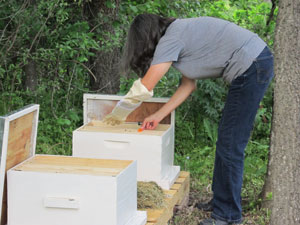A few weeks ago I wrote about my carefully orchestrated schedule
to keep predators and prey separated. This week, in spite of my efforts, there
was a death in my family. My beloved orange and white tabby, Orange Juice (OJ),
is gone, and my own dogs killed him. This is painful to admit.
Before I tell you how OJ died, I want to tell you about his life. Like so many of my critters, I don’t know where he came
from or what his story was. But I loved him dearly.
One cool spring night in March 2008, while putting food
outside for the barn cats, I noticed a large, scraggly, orange and white tabby cat
hanging back near a grove of trees in the yard. I called to him, but he ran
off.
Every night when I put out the food the stray cat was
there, but he never let me get close. I started sitting by the door and calling
to him each night; gradually he came closer and closer.
By August, the stray finally let me touch his head, and
the rest was history. A week later I was able to get him into a carry cage to
go to the vet. He had the usual afflictions of a stray: fleas, ticks, ear
mites, and internal parasites. My vet said he was about 10 years old, and since
he had not been neutered, I had that done before I brought him home.
My then 2-year old granddaughter was visiting at the
time, and while I called the new cat Orange (because of his color), she
insisted his name should be Orange Juice. OJ’s the name that stuck.
Normally a male cat neutered so late in life will be
rather unpleasant and continue to mark his scent in the house, but OJ was a
perfect gentleman. He quickly became an indoor cat, and filled an empty space
at the foot of our bed, day and night.
OJ was full of life, but also full of mischief. When my
husband and I played cards at night, OJ often jumped in the middle
of the table and batted the cards onto the floor. When I sat at my desk to do
school work, he would sit in my lap and purr his encouragement. Often when I
petted him he would playfully bite my hand.
Unfortunately, OJ also liked to taunt the dogs, running
to get inside the house just before they got to him. Other times he would sit
silently by the side of the road while the dogs ran obliviously by him, then
turn to hiss when they were too far away to catch him. I’m sure it never
occurred to OJ, but I knew that as he got older and ran slower, this might
become a deadly game.
And so it did. Last Sunday, I heard the dogs barking by
the garage, and went out to find OJ on the ground surrounded by my four younger
dogs. We quickly took him to the Animal Emergency Room. He had a punctured
lung, and several bite wounds, but did fairly well throughout Sunday night and
early Monday morning.
The Animal Emergency Room is only open nights and
weekends, so on Monday morning I picked up OJ and drove him to my regular vet.
He purred and licked my hand as I held him in the car. I was optimistic that he
would be okay.
But it was not to be so. My vet knows that I won't allow animals to suffer because I'm afraid to let them die. When OJ became
distressed Tuesday morning, she euthanized him. I know it was not an easy
decision for her, because she knew OJ too, but it was the right
decision.
We buried OJ Tuesday afternoon, near the same grove of
trees he once hid in when I called to him at night. I can see his grave from my
door.
I know my dogs had no malice aforethought —they are, as I
have told you, killing machines, and were just doing what a pack of dogs will
do. But I’ve struggled unsuccessfully all week to forgive and forget. I’m not
sure I'm capable of doing so.
In the meantime, I think again how fragile life is. And I
am reminded of the importance of keeping my predators separated from their prey.





